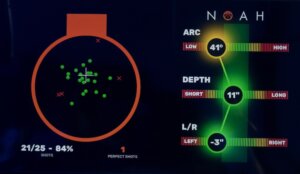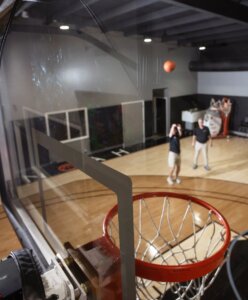
Longtime UAB Blazers head basketball coach Gene Bartow had a simple – though somewhat grammatically incorrect – way of summing up the thin line between success and failure in his chosen sport.
“Well, there’s no doubt, if you don’t shoot good you don’t look good,” Bartow often said in his folksy manner.
Indeed, while rebounding, passing and defense are all important components of the game, the bottom-line goal of basketball is to put the basketball in the goal. And for more than 20 years, Alabama native John Carter has been utilizing technology to help players become better shooters though the Noah Basketball System.
The original concept of Noah Basketball was to employ computer sensors and data to analyze and adjust the arc that players put on their shots in an effort to improve their shooting percentage. The company name is a play on words in reference to the biblical Noah, who Carter said had “the perfect arc.”
The idea began in the early 2000s with a California physicist and venture capitalist named Alan Marty, who simply wanted to help his high school-aged daughter with her shooting. But Carter took Marty’s design and set out on a fastbreak with it. Two decades later, the Noah Basketball system is now used by 28 of the 30 teams in the NBA and several in the WNBA, along with more than 200 college programs and more than 1,000 high-school teams.
“I pinch myself occasionally, because I’m just a guy from Elkmont, Alabama, who loves basketball and engineering, and now I have NBA coaches who want to talk with me,” Carter says with a chuckle.
That certainly was not the case initially, as the company scuffled along for several years while trying to gain widespread acceptance. In fact, Carter says some of the coaches he talked to in those early days were downright “rude” in their rejections.
“The resistance we received was strong,” Carter says. “The most common quote I got was, ‘You can’t use a computer to teach a player to shoot a basketball.’ And I’d say about 80% of the players didn’t like it either.”
But Carter gradually gained converts as the system proved to be successful in improving a team’s shooting percentage. One of the earliest was current Samford head coach Lennie Acuff, who was head coach at the University of Alabama in Huntsville from 1997 to 2019.
“John showed up and said he had this machine that can tell you the perfect arc for a basketball shot,” Acuff recalls. “He seemed like a really nice guy, so I said we’d try it. Then he wheels in this big machine that looked like an old jukebox.

“I felt like we were kind of his guinea pigs for what he was trying to do. Then the next thing I know, everything he was saying was working. It was giving kids immediate data-driven feedback, and they became better shooters.”
Still, the system had limitations, and success was hardly a slam dunk. But things changed dramatically in 2017 when Noah Basketball began analyzing shots with depth sensors, the types that are used in driverless cars and other robotic devices.
“That was huge, because instead of only being able to track a free throw or a straight-ahead shot, now we were able to track every shot on the floor,” Carter says. “And not only could we track the trajectory (arc), but we are able to track the position within the rim (depth) as well as how far the shots went to the left or right.”
Carter and his small team took this new product to the annual MIT Sloan Sports Analytics Conference in Boston. Officials there were so impressed that Noah Basketball won first place in both the research category and the startup company competition.
“We went from having a couple of NBA teams interested in us to suddenly having NBA teams all over us,” Carter says. “That really was almost a relaunch for the company.”
Since then, Noah Basketball has expanded its ability to monitor shots, as well as the type of data it produces. The company now uses facial recognition technology, eliminating the need for players to wear sensors or outside parties to enter data. In addition, the former “jukebox” machine has been reduced to a single sensor that easily can be attached to a backboard.

The system has become so advanced that a coach can use an app to access video of every shot a player has taken, then filter it to show only shots that were missed in a certain way (i.e., to the left, off the back rim, etc.). “So, the coach can get with a player and have all that data and those videos filtered immediately, and they can go over it together,” Carter says.
Of course, there are still plenty of old-school coaches who might resist the thought of putting so much computerized data into a sport that often relies on instincts and split-second decision making. Acuff, who is 60, says he doesn’t want players “to have paralysis by analysis.”
“I don’t want our guys to be so analytical they become robots,” Acuff says. “But this is really something you use more in workouts. What you’re trying to create is muscle memory. If you do it often enough, you automatically know it. So, it becomes more of a teaching mechanism. If you really buy into the numbers and figure out consistency of arc, consistency of depth, it works.”
Plus, as Carter points out, “We now have a whole generation of players who grew up with technology in their pockets. So, they expect data and apps and computers in almost everything they do.”

The growth of Noah Basketball has enabled the company to move into a 12,000-square-foot facility in Madison that includes an indoor basketball court (previously, the company had to reserve space at local gyms to test its products). Carter says Noah now has more than 20 full-time employees, most of whom have some sort of basketball-playing experience in their background.
And perhaps most importantly, Noah Basketball has collected data from more than 600 million basketball shots over the years.
“After all that, we know the answers of what leads to good shooting and what leads to poor shooting,” Carter says. “So, we can quickly diagnose what the problem is, and then they can go back and work on those. If you have the answers to the test, you’re a pretty smart person.”
And in turn, you’ll look pretty good on the basketball court.
Cary Estes and David Higginbotham are freelance contributors to Business Alabama. Estes is based in Birmingham and Higginbotham in Decatur.
This article appears in the November 2025 issue of Business Alabama.



